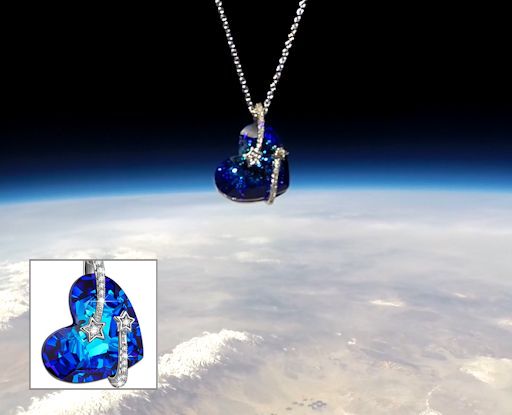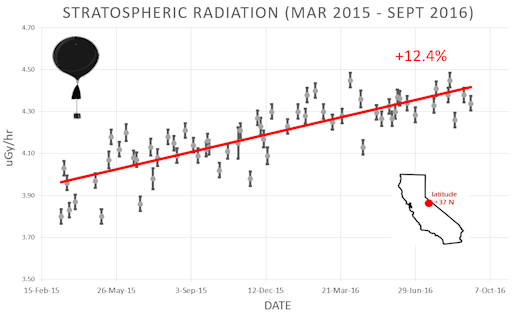 | | | Switch to: Europe, USA, New Zealand, Antarctica Credit: NOAA/Ovation  Planetary K-index Planetary K-index
Now: Kp= 4 unsettled
24-hr max: Kp= 4 unsettled
explanation | more data
Interplanetary Mag. Field
Btotal: 4.0 nT
Bz: -1.8 nT south
more data: ACE, DSCOVR
Updated: Today at 0003 UT  Coronal Holes: 24 Apr 17 Coronal Holes: 24 Apr 17 
Earth is inside a stream of solar wind flowing from this large coronal hole. Credit: NASA/SDO.  Noctilucent Clouds The southern season for noctilucent clouds began on Nov. 17, 2016. Come back to this spot every day to see the "daily daisy" from NASA's AIM spacecraft, which is monitoring the dance of electric-blue around the Antarctic Circle. Switch view: Ross Ice Shelf, Antarctic Peninsula, East Antarctica, Polar Updated at: 02-24-2017 17:55:02 Noctilucent Clouds The southern season for noctilucent clouds began on Nov. 17, 2016. Come back to this spot every day to see the "daily daisy" from NASA's AIM spacecraft, which is monitoring the dance of electric-blue around the Antarctic Circle. Switch view: Ross Ice Shelf, Antarctic Peninsula, East Antarctica, Polar Updated at: 02-24-2017 17:55:02  SPACE WEATHER
NOAA Forecasts | | Updated at: 2017 Apr 24 2200 UTC FLARE | 0-24 hr | 24-48 hr | CLASS M | 01 % | 01 % | CLASS X | 01 % | 01 % |  Geomagnetic Storms: Geomagnetic Storms:
Probabilities for significant disturbances in Earth's magnetic field are given for three activity levels: active, minor storm, severe storm Updated at: 2017 Apr 24 2200 UTC Mid-latitudes | 0-24 hr | 24-48 hr | ACTIVE | 40 % | 40 % | MINOR | 25 % | 25 % | SEVERE | 01 % | 01 % | High latitudes | 0-24 hr | 24-48 hr | ACTIVE | 10 % | 10 % | MINOR | 25 % | 25 % | SEVERE | 60 % | 60 % | | | |  | | | | | | | | | | | Looking for a far-out Mother's Day gift? Find something truly out of this world in the Earth to Sky Store. Space roses, Cosmic Reindeer, Arctic space pendants, and more! | | | EXPLOSION ON THE SUN: On April 23rd, a dark filament of magnetism on the sun exploded. See the movie from NASA's Solar Dynamics Observatory. A new analysis shows that debris from the explosion will not hit Earth. There is, however, plenty of space weather without it. Read on... SOLAR WIND STORM SPARKS AURORAS: Earth is inside a stream of solar wind spewing from a large hole in the sun's atmosphere. Fitfully blowing faster than 700 km/s, the wind's gusty pressure on Earth's magnetic field is sparking bright auroras around the poles. Air traveler J. Palys was flying 30,000 feet over Greenland last night when he saw this from the window seat: 
"Spectacular in-flight entertainment on my flight from San Francisco to Frankfurt last night," he says. "As we flew over Greenland, I saw a bright, colorful and very dynamic display of aurora borealis." These polar lights will probably dance for at least one more night as Earth continues its passage through the solar wind stream. Gaseous material in this stream is threaded with "negative polarity" magnetic fields. Such fields do a good job connecting to Earth's magnetosphere and energizing geomagnetic storms. NOAA forecasters estimate a 60% chance of G1-class storms in the next 24 hours. Free: Aurora Alerts Realtime Aurora Photo Gallery
MARCHING FOR SCIENCE IN THE STRATOSPHERE: On April 22nd during the worldwide March for Science, Spaceweather.com teamed up with the students of Earth to Sky Calculus for a march to the stratosphere. We decided to honor a modern champion of science, the US National Park Ranger, by launching a ranger figurine to the edge of space. 
Carried aloft by a giant helium balloon, he soared 34.1 km (111,900 feet) above Earth's surface. At the apex of the flight, the balloon exploded (as planned) and the payload parachuted back to Earth, landing in a wilderness area near Lida, Nevada. The ranger traveled alongside an array of radiation sensors that we use on a regular basis to monitor cosmic rays in Earth's atmosphere. Realtime Space Weather Photo Gallery THESE PENDANTS HAVE TOUCHED SPACE: These pendants have touched space--and returned to Earth in time for Mother's Day. On April 15, 2017, the students of Earth to Sky Calculus flew a payload-full of heart-shaped Venus pendants to the stratosphere onboard a high-altitude helium balloon. Here's one, 111,550 feet above the Sierras of central California: 
These blue jewels make great Mother's Day gifts--and you have have one for $99.95. Each glittering pendant comes with a greeting card showing the jewelry in flight and telling the story of its journey to the stratosphere and back again. More far-out Mother's Day gifts may be found in the Earth to Sky Store. All proceeds support atmospheric radiation monitoring and hands-on STEM education. Realtime Aurora Photo Gallery
Realtime Comet Photo Gallery Every night, a network of NASA all-sky cameras scans the skies above the United States for meteoritic fireballs. Automated software maintained by NASA's Meteoroid Environment Office calculates their orbits, velocity, penetration depth in Earth's atmosphere and many other characteristics. Daily results are presented here on Spaceweather.com. On Apr. 24, 2017, the network reported 6 fireballs.
(6 sporadics)  In this diagram of the inner solar system, all of the fireball orbits intersect at a single point--Earth. The orbits are color-coded by velocity, from slow (red) to fast (blue). [Larger image] [movies] Potentially Hazardous Asteroids ( PHAs) are space rocks larger than approximately 100m that can come closer to Earth than 0.05 AU. None of the known PHAs is on a collision course with our planet, although astronomers are finding new ones all the time. On April 24, 2017 there were 1798 potentially hazardous asteroids.  | Recent & Upcoming Earth-asteroid encounters: | Asteroid | Date(UT) | Miss Distance | Velocity (km/s) | Diameter (m) | | 2017 GO4 | 2017-Apr-15 | 13.8 LD | 6 | 34 | | 2014 UR | 2017-Apr-19 | 18.8 LD | 4.4 | 17 | | 2014 JO25 | 2017-Apr-19 | 4.6 LD | 33.6 | 852 | | 2017 GL4 | 2017-Apr-20 | 17.5 LD | 7.4 | 22 | | 2017 GM4 | 2017-Apr-20 | 13.1 LD | 16.6 | 143 | | 2017 FH101 | 2017-Apr-24 | 18.8 LD | 9.9 | 103 | | 2017 FE157 | 2017-Apr-29 | 18.6 LD | 8.6 | 64 | | 2015 VD1 | 2017-May-07 | 18.2 LD | 10.5 | 34 | | 2012 EC | 2017-May-16 | 19.5 LD | 4.5 | 74 | | 2017 CS | 2017-May-29 | 8 LD | 9.1 | 468 | | 418094 | 2017-Jun-01 | 8 LD | 23.2 | 490 | Notes: LD means "Lunar Distance." 1 LD = 384,401 km, the distance between Earth and the Moon. 1 LD also equals 0.00256 AU. MAG is the visual magnitude of the asteroid on the date of closest approach. | | Cosmic Rays in the Atmosphere |
Readers, thank you for your patience while we continue to develop this new section of Spaceweather.com. We've been working to streamline our data reduction, allowing us to post results from balloon flights much more rapidly, and we have developed a new data product, shown here: 
This plot displays radiation measurements not only in the stratosphere, but also at aviation altitudes. Dose rates are expessed as multiples of sea level. For instance, we see that boarding a plane that flies at 25,000 feet exposes passengers to dose rates ~10x higher than sea level. At 40,000 feet, the multiplier is closer to 50x. These measurements are made by our usual cosmic ray payload as it passes through aviation altitudes en route to the stratosphere over California. What is this all about? Approximately once a week, Spaceweather.com and the students of Earth to Sky Calculus fly space weather balloons to the stratosphere over California. These balloons are equipped with radiation sensors that detect cosmic rays, a surprisingly "down to Earth" form of space weather. Cosmic rays can seed clouds, trigger lightning, and penetrate commercial airplanes. Furthermore, there are studies ( #1, #2, #3, #4) linking cosmic rays with cardiac arrhythmias and sudden cardiac death in the general population. Our latest measurements show that cosmic rays are intensifying, with an increase of more than 12% since 2015: 
Why are cosmic rays intensifying? The main reason is the sun. Solar storm clouds such as coronal mass ejections (CMEs) sweep aside cosmic rays when they pass by Earth. During Solar Maximum, CMEs are abundant and cosmic rays are held at bay. Now, however, the solar cycle is swinging toward Solar Minimum, allowing cosmic rays to return. Another reason could be the weakening of Earth's magnetic field, which helps protect us from deep-space radiation. The radiation sensors onboard our helium balloons detect X-rays and gamma-rays in the energy range 10 keV to 20 MeV. These energies span the range of medical X-ray machines and airport security scanners. The data points in the graph above correspond to the peak of the Reneger-Pfotzer maximum, which lies about 67,000 feet above central California. When cosmic rays crash into Earth's atmosphere, they produce a spray of secondary particles that is most intense at the entrance to the stratosphere. Physicists Eric Reneger and Georg Pfotzer discovered the maximum using balloons in the 1930s and it is what we are measuring today. | | The official U.S. government space weather bureau | | | The first place to look for information about sundogs, pillars, rainbows and related phenomena. | | | Researchers call it a "Hubble for the sun." SDO is the most advanced solar observatory ever. | | | 3D views of the sun from NASA's Solar and Terrestrial Relations Observatory | | | Realtime and archival images of the Sun from SOHO. | | | from the NOAA Space Environment Center | | | a proud supporter of science education and Spaceweather.com | | | fun to read, but should be taken with a grain of salt! Forecasts looking ahead more than a few days are often wrong. | | | from the NOAA Space Environment Center | | | the underlying science of space weather |  | Beautyz for top beauty products reviews and their buying guides |  | Reviews here can help you to pick up best memory foam mattresses. | | | These links help Spaceweather.com stay online. Thank you to our supporters! | | | | | | | | |  | |  |   | ©2016 Spaceweather.com. All rights reserved. This site is penned daily by Dr. Tony Phillips. | |

